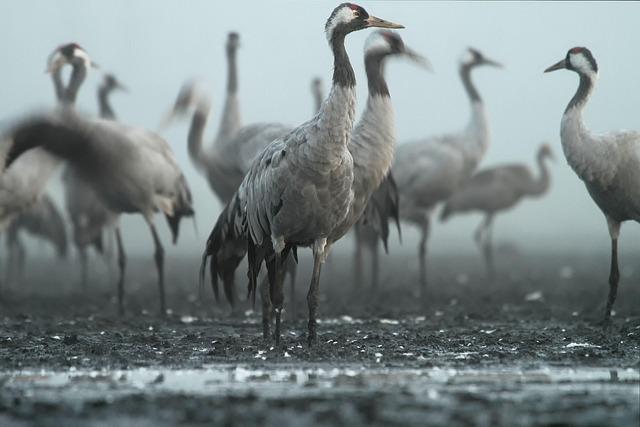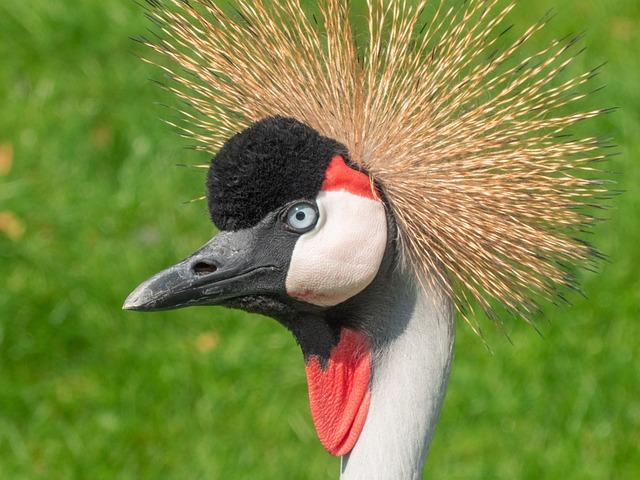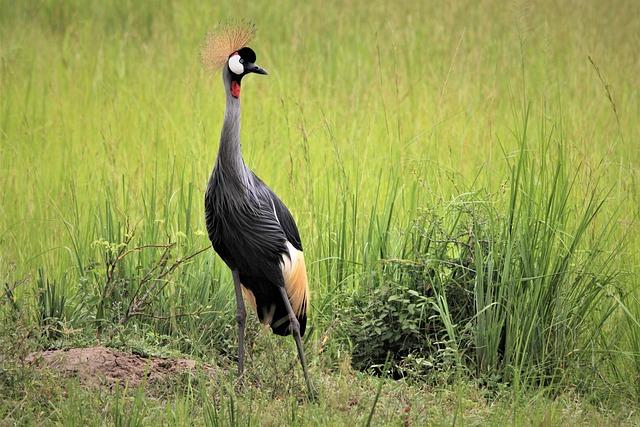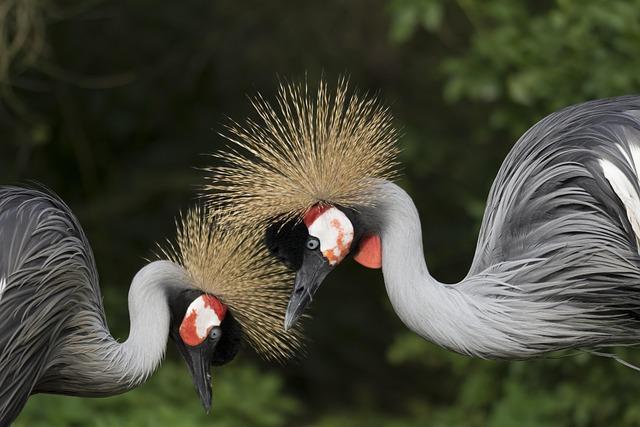Creation
The crested crane, Uganda’s nationwide image and a shocking embodiment of the rustic’s wealthy biodiversity, is going through an alarming danger of extinction. Famend for its putting plumage and distinctive courtship dance, this swish hen has grow to be a logo of nationwide satisfaction. Alternatively, as habitat loss, poaching, and local weather trade accentuate, the way forward for the crested crane hangs within the stability. This newsletter delves into the multifaceted demanding situations going through this iconic species, exploring the ecological that means of the crested crane and the pressing conservation efforts had to safeguard its survival. As Uganda grapples with the effects of environmental degradation and unsustainable practices, the plight of the crested crane serves as a poignant reminder of the subtle interconnection between human task and flora and fauna preservation.
The Decline of Uganda’s Nationwide Fowl and Its Ecological Importance
The enduring crested crane, famend for its putting attractiveness and swish stature, is going through a deadly decline in Uganda, in large part attributed to habitat loss and human encroachment. With wetlands being tired for agriculture and concrete enlargement, the valuable ecosystems that maintain the crane are unexpectedly diminishing.This hen is not just a countrywide image but in addition an integral part of the native ecosystem. The lack of the crested crane may characterize broader ecological imbalances, as those birds give a contribution to the well being in their habitats via controlling insect populations and dispersing seeds.
Moreover, the decline of the crested crane raises issues about biodiversity and the subtle interconnections inside of Uganda’s environments. Protective this species is necessary,as their presence signifies a thriving ecosystem. Precedence movements to safeguard the crested crane come with:
- Organising safe wetland spaces to preserve their habitats.
- Selling enduring agricultural practices that reduce environmental have an effect on.
- Expanding public consciousness in regards to the ecological significance of the crested crane.

Habitat loss and Human Encroachment threatening Crested Crane Populations
The lack of herbal habitats because of agricultural enlargement, city construction, and commercial actions poses a significant danger to the crested crane, a logo of Uganda’s wealthy biodiversity. As wetlands are tired and forests cleared, those majestic birds in finding themselves more and more squeezed into fragmented environments that fight to fortify their survival.Their reliance on explicit ecosystems makes them specifically susceptible to such adjustments, resulting in a decline in appropriate nesting in addition to feeding grounds. Moreover, air pollution in those habitats compromises their well being and reproductive luck, exacerbating the pressures they face in an ever-changing panorama.
Human encroachment now not handiest disrupts the crested crane’s herbal conduct but in addition ends up in direct struggle between the species and native populations. As agriculture intensifies, the cranes are steadily sufficient considered as pests, resulting in unfavorable interactions that threaten their protection. Group consciousness and conservation projects can play a a very powerful position in mitigating those threats, emphasizing the significance of protecting those birds as a part of Uganda’s cultural heritage. To nurture their populations,methods equivalent to creating protected areas and selling sustainable land-use practices will have to be carried out. Collaborative efforts can lend a hand make sure that each human wishes and flora and fauna coexist in solidarity, safeguarding the way forward for the crested crane.

The Affect of Local weather Exchange on Crested Crane Migration Patterns
The original migratory patterns of Uganda’s crested crane, a logo of the country, are more and more disrupted via local weather trade. As temperatures upward push and climate patterns grow to be erratic, those birds face demanding situations to find appropriate habitats and meals assets. Alterations of their migratory routes may end up in lowered breeding luck and greater pageant for dwindling sources. One of the maximum regarding components impacting their migration come with:
- Temperature Fluctuations: Emerging temperatures can affect the supply in their meals assets, equivalent to aquatic crops and bugs.
- Converting rainfall patterns: Abnormal precipitation impacts wetland ecosystems, crucial for feeding and nesting.
- Higher human task: City enlargement and agricultural construction encroach on their herbal habitats, making migration perilous.
To higher perceive those affects, fresh research have printed important adjustments within the timing and routes of the crested crane’s migrations. Knowledge presentations that previously 20 years, there was a notable shift of their arrival and departure instances, reflecting the pressing wish to adapt to a warming local weather. The desk beneath highlights the developments seen in numerous areas:
| Area | Reasonable Arrival Time (Years) | Migration Path adjustments (km) |
|---|---|---|
| Lake Victoria Basin | Previous via 3 weeks | +15 km East |
| Rwenzori Mountains | Later via 2 weeks | -20 km North |
| western Uganda Marshes | Previous via 1 week | +10 km South |
Figuring out those environmental adjustments is a very powerful for conservation efforts aimed toward protective this iconic species. Ongoing analysis is very important to increase methods that mitigate the affects of local weather trade, making sure that the crested crane continues to thrive in its local habitat.

Conservation Efforts: Demanding situations and Alternatives for Protective the Crested Crane
The conservation of Uganda’s iconic crested crane faces a myriad of demanding situations that complicate efforts to offer protection to this image of nationwide satisfaction. Habitat loss because of urbanization, agriculture, and infrastructure construction has considerably diminished appropriate dwelling areas for the cranes.Moreover, local weather trade exacerbates those problems via changing wetlands, wich are a very powerful for the cranes’ breeding and feeding. Different demanding situations come with poaching and unlawful industry in wild birds, which threaten their inhabitants without delay. Native communities ceaselessly lack consciousness of the cranes’ ecological significance, resulting in practices that additional endanger their survival. The mix of those components calls for pressing and complete motion to curb the decline in crane numbers.
Amid those daunting demanding situations, there are promising alternatives for efficient conservation methods. Collaborative efforts between executive companies, non-governmental organizations, and native communities can advertise sustainable practices. Key methods come with:
- Organising safe spaces and nationwide parks the place cranes can thrive with out human interference.
- Imposing community-based conservation methods that have interaction locals in protective the species.
- Selling eco-tourism to foster financial incentives for protecting herbal habitats.
Additionally, instructional outreach aimed toward informing the general public in regards to the ecological importance of the crested crane is necessary.By way of connecting peopel to their herbal heritage, those projects can domesticate a way of stewardship that encourages community members to offer protection to and have fun those outstanding birds.

The preservation of Uganda’s majestic crested crane hinges considerably at the lively involvement of native communities. By way of fostering a way of possession amongst citizens, efforts to preserve this iconic hen can grow to be simpler.Key methods come with:
- Consciousness Campaigns: Teaching locals in regards to the ecological significance of the crested crane.
- Participatory Conservation Tasks: involving network individuals in habitat recovery and coverage projects.
- financial Incentives: Offering selection livelihood alternatives that inspire the safety of the crested crane, moderately then its exploitation.
Via collaborative efforts,communities can power trade and start up sustainable practices that without delay receive advantages the crested crane inhabitants. Present projects come with organising native conservation teams, which empower members to grow to be stewards in their habitat. Those teams steadily sufficient have interaction in actions equivalent to:
| Task | Affect |
|---|---|
| Habitat Cleanup | Progressed nesting prerequisites for crested cranes |
| Group Workshops | Enhanced wisdom of flora and fauna conservation |
| Fowl gazing Excursions | Earnings technology via ecotourism |

Coverage Suggestions for Sustainable Natural world Control in Uganda
To deal with the alarming decline of Uganda’s iconic crested crane, a multifaceted way is important to verify sustainable wildlife management. Key projects must come with the implementation of strict anti-poaching rules and enhanced coaching for legislation enforcement companies to offer protection to those birds from unlawful searching. Moreover, selling community-based conservation methods can empower native populations to have interaction in protective their herbal heritage, providing financial incentives via ecotourism and sustainable practices. Taking part with NGOs and global flora and fauna organizations too can catalyze efforts to boost consciousness and price range for conservation initiatives.
Moreover, it is very important to make stronger habitat coverage and recovery efforts throughout key wetland spaces the place the crested crane flourishes. This may also be accomplished via:
- Organising safe spaces: Designating crucial habitats as nationwide parks or reserves.
- Recovery projects: Making an investment in wetland rehabilitation to revive degraded ecosystems.
- Regulating agricultural enlargement: Imposing insurance policies to keep an eye on land use that threatens those habitats.
Accomplishing common analysis and tracking of flora and fauna populations may also be certain adaptive control methods are in position to reply to replacing environmental and social dynamics.

To Conclude
the plight of Uganda’s iconic crested crane serves as a stark reminder of the wider environmental demanding situations going through many species international. Habitat loss, local weather trade, and human encroachment threaten now not handiest this nationwide image but in addition the subtle ecosystems upon which it is based. as consciousness grows, it’s crucial for each native communities and global stakeholders to unite in conservation efforts.Persevered advocacy, sustainable practices, and proactive measures may nonetheless save this majestic hen from the threshold of extinction. The crested crane’s destiny intertwines with that of Uganda’s herbal heritage; protecting it is going to require a collective dedication to safeguarding the wealthy biodiversity that defines this colourful country.
Source link : https://afric.news/2025/02/22/why-ugandas-iconic-crested-crane-faces-extinction-bbc-com/
Creator : Charlotte Adams
Submit date : 2025-02-22 15:39:00
Copyright for syndicated content material belongs to the connected Source.



